If you’ve been around weed a while, you’re probably familiar with the term “entourage effect.” But like all things cannabis, there’s quite a bit more than meets the eye. The entourage effect is a concept that goes beyond the mere presence of THC and CBD, highlighting the intricate interplay between cannabinoids, terpenes, and flavonoids within the cannabis plant. This phenomenon, with its synergistic magic, plays a huge role in the therapeutic potential of the cannabis plant as a whole.
In this article, we’ll explore what the entourage effect is, why it matters, and how it impacts both recreational users and medical cannabis patients. The interactions between cannabinoids, terpenes, and flavonoids converge to create a symphony of effects greater than the sum of their parts alone.
What is the Entourage Effect?
More or less, the entourage effect is a phenomenon showcasing that the many unique compounds in cannabis may affect how cannabis products feel. This potential synergy highlights the idea that cannabis is strongest when all its compounds remain intact to produce the synergy and amplify or mitigate effects. While the entourage effect is still considered a theory, there is quite a bit of evidence to support it.
In cannabis, there are over 550 unique chemical compounds and over 100 individual phytocannabinoids. These components – cannabinoids, terpenes, and flavonoids – each possess unique characteristics and effects. For instance, cannabinoids like THC and CBD are well-known for their therapeutic properties, while terpenes contribute to the distinct aroma and flavour profiles of different cannabis strains. Flavonoids, though less discussed, also play a role in the plant’s overall therapeutic potential, as evidence suggests that cannabis feels stronger with them than without them.
What sets the entourage effect apart is the potential synergy that occurs when these components interact. Even though each distinct compound offers its own list of potential effects or benefits, the relationship they share when they’re found together may change the overall experience. Each individual affects each individual, meaning that when they’re taken together, they may amplify and modulate each other, making for a unique collective impact.
For example, consider the partnership between terpenes and cannabinoids. Certain terpenes, like myrcene and linalool, have been found to enhance the effects of cannabinoids, contributing to feelings of relaxation or euphoria. On the other hand, there are instances where the entourage effect may mitigate effects. For example, b-caryophyllene terpenes may have an anxiety-reducing effect, making it a good addition to high-THC products, which tend to cause anxiety. Together, b-caryophyllene and THC may produce a more neutral impact against anxiety.
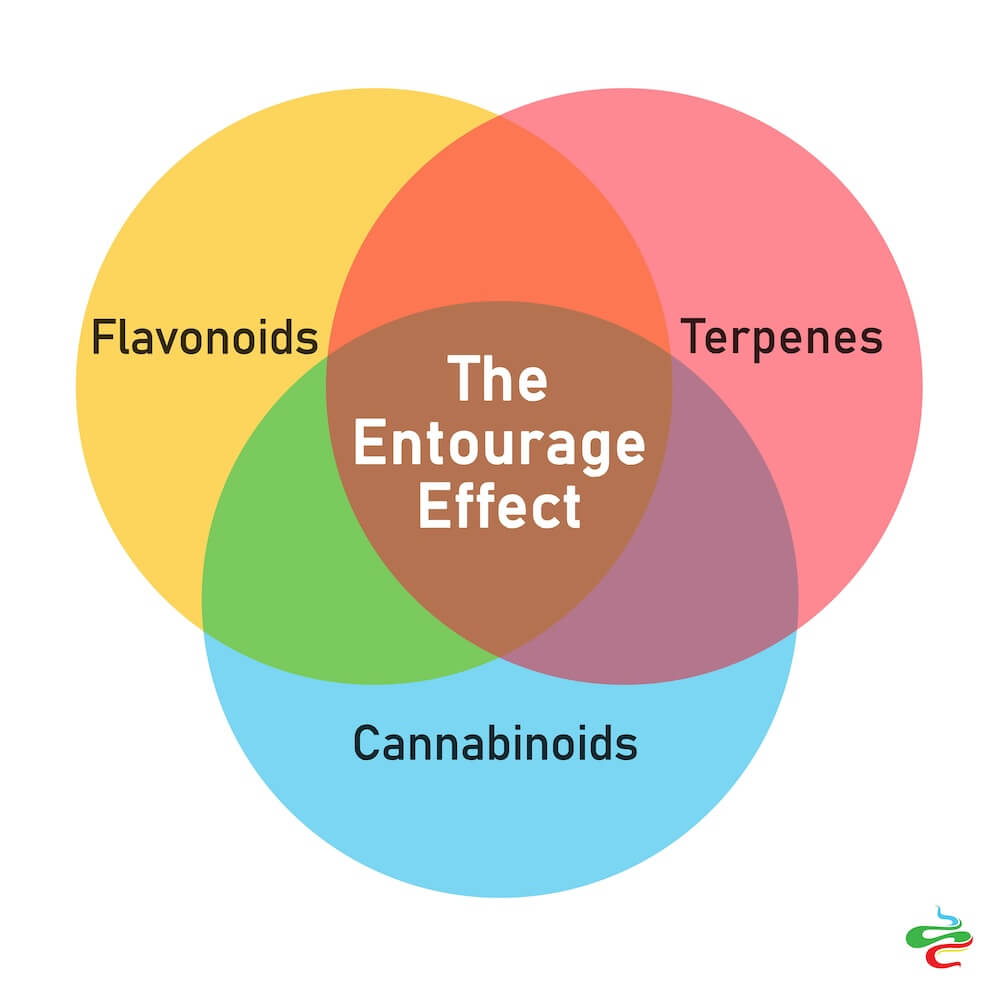
How Does the Entourage Effect Work?
The entourage effect operates on the principle of synergy, where the combined action of multiple components produces effects greater than the sum of the parts alone. Within the cannabis plant, this phenomenon manifests through the intricate interactions between cannabinoids, terpenes, and flavonoids.
Cannabinoids, the chemical compounds unique to cannabis, interact with the body’s endocannabinoid system (ECS), which plays a crucial role in regulating various physiological functions that run in the background, like immune system function, sleeping and waking cycle, appetite, mood, and more.
The system is made up of endocannabinoid receptors and endocannabinoids, which are a lot like the cannabinoids found in cannabis. These naturally produced chemical messengers help the ECS do its job, and cannabinoids interact with the ECS the same way as our natural endocannabinoids do. THC, the cannabinoid that gets you high, is perhaps the most well-known, but CBD and others also exert their effects by interacting with the cannabinoid receptors found throughout the ECS.
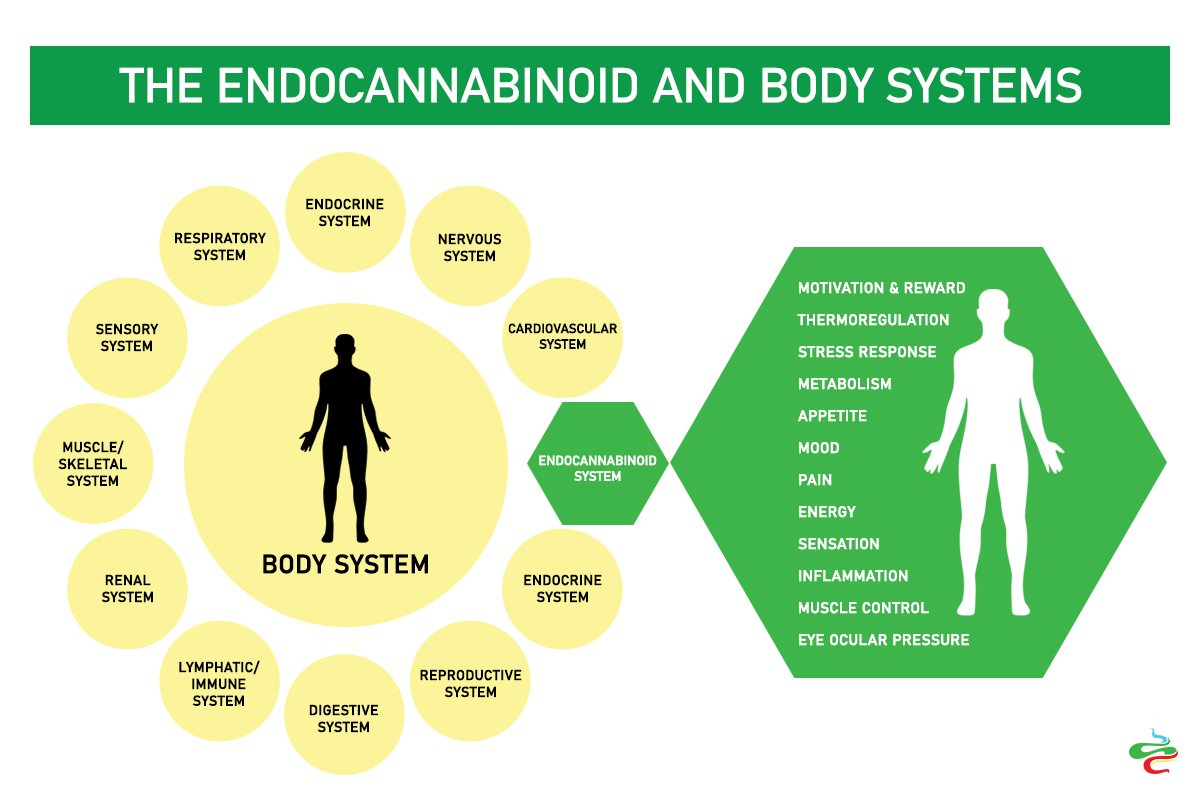
Terpenes, on the other hand, are aromatic compounds responsible for the diverse flavours and aromas of cannabis strains. They also come along with their own potentially therapeutic properties, such as anti-inflammatory and anti-anxiety effects. Some evidence suggests that terpenes steer the way your high feels by amplifying or mitigating the effects of cannabinoids and bringing their own relaxing, sedative, focusing, or energising effects to the table.
Flavonoids, although less studied compared to cannabinoids and terpenes are another group of compounds found in cannabis with potential therapeutic benefits. Flavonoids are phytonutrients responsible for the vivid colours in fruits, vegetables, and flowers, including cannabis. In cannabis, flavonoids may contribute to the plant’s overall antioxidant and anti-inflammatory properties, much like cannabinoids and terpenes. While their specific effects on the human body are still being researched, flavonoids are believed to interact synergistically with cannabinoids and terpenes, further enhancing the entourage effect.
More or less, enjoying a full-spectrum product rich in cannabinoids, terpenes, and flavonoids may offer you a broader spectrum of effects that make your medicine feel stronger. As these compounds are processed by the body through the ECS, you can experience the unique synergy firsthand.
What Are the Benefits of the Entourage Effect?
The entourage effect offers many potential benefits, from enhanced therapeutic effects to a more nuanced and balanced experience. By harnessing the synergistic interactions between cannabinoids, terpenes, and flavonoids, your weed feels stronger.
For starters, the combined action of cannabinoids, terpenes, and flavonoids might lead to more potent and diverse therapeutic effects than isolated compounds. For example, research suggests that the entourage effect may enhance the analgesic properties of cannabis, making it more effective in managing pain. Additionally, the synergistic interactions between cannabinoids and terpenes may contribute to the anti-inflammatory, anxiolytic, and neuroprotective effects of cannabis, potentially offering relief for a wide range of symptoms.
Cannabinoids and terpenes have also been shown to work synergistically, amplifying each other’s effects and modulating their overall impact on the body. For instance, the presence of specific terpenes may enhance the bioavailability of cannabinoids, allowing for better absorption and distribution throughout the body. This synergy not only increases the therapeutic potential of cannabis but also offers a more balanced and tailored experience for users.
The critical point is that regardless of whether you’re a medical patient or a recreational user, the entourage effect may boost effects. By consuming whole-plant cannabis extracts rich in cannabinoids, terpenes, and flavonoids, patients may benefit from a more comprehensive and personalised approach to symptom management, and recreational users may have a more effective high.

Is the Entourage Effect Real?
Like many things in the scientific community, the entourage effect is up for debate. While numerous studies support the idea that the interaction between cannabinoids, terpenes, and flavonoids enhances the therapeutic effects of cannabis, there are also dissenting voices challenging its existence.
The entourage effect was first observed and studied by Dr. Ethan Russo in 2011, who proposed that the combined action of multiple cannabis compounds leads to synergistic effects that are more effective than isolated compounds alone. However, some researchers have questioned the methodology and conclusions of Dr. Russo’s study, suggesting that the “entourage effect” may just be a marketing term and that further research is needed to validate the entourage effect conclusively.
Despite the controversy, there is growing evidence suggesting that the entourage effect is indeed real, with studies demonstrating synergistic interactions between cannabinoids, terpenes, and flavonoids in preclinical and clinical settings. However, limitations and gaps in current research highlight the need for continued investigation to fully understand the mechanisms underlying the entourage effect and its implications for cannabis therapeutics.
While the entourage effect may still be subject to debate, the accumulating evidence suggests that the synergistic interactions between cannabis compounds play a significant role in shaping the plant’s therapeutic effects. Further research is necessary to say for sure the full extent of the entourage effect, but even if we’re not sure of its existence, most people agree that fresh, flavourful cannabis flowers feel a lot different than THC isolate alone.
The Entourage Effect Between Cannabinoids, Terpenes and Flavonoids
Understanding the entourage effect involves taking a closer look at the relationships between cannabinoids, terpenes, and flavonoids within the cannabis plant. These compounds work synergistically to produce a wide array of therapeutic effects together, but each compound also shares an entourage effect with other compounds like it.
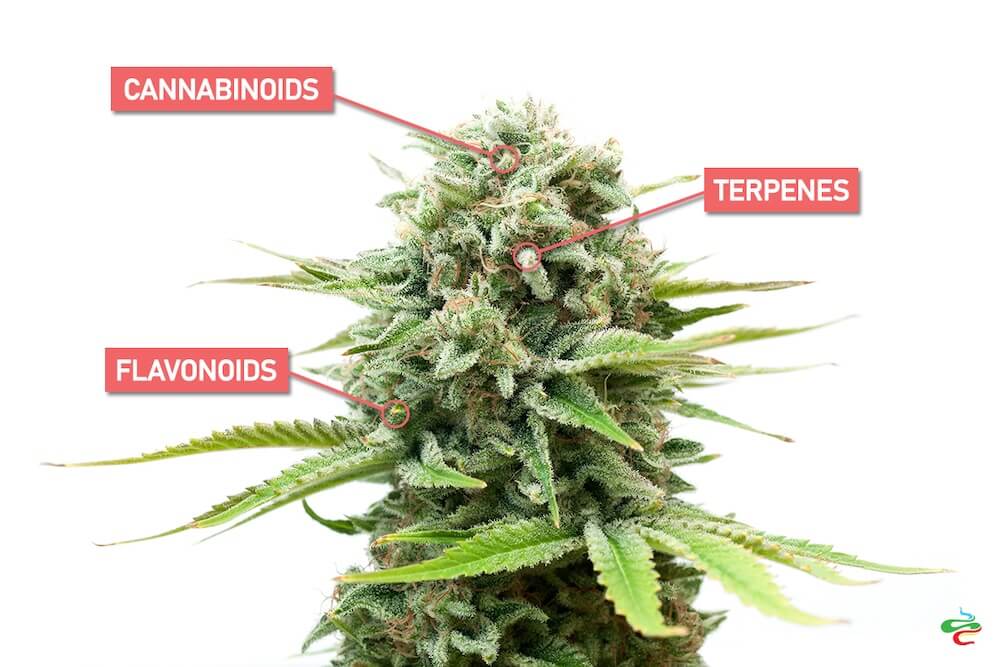
The Entourage Effect Between Cannabinoids
As we mentioned, cannabinoids are chemical compounds unique to cannabis that interact with your ECS. While THC and CBD are the most well-known cannabinoids, there are over a hundred others present in cannabis, each with its own potential therapeutic effects.
The entourage effect between cannabinoids involves the synergistic interactions between these compounds, leading to enhanced therapeutic effects. For example, THC and CBD have been found to modulate each other’s effects, with CBD enhancing its analgesic and anti-inflammatory effects. On the other hand, CBN may enhance the sedative effects of THC for sleep.
Even non-intoxicating cannabinoids share an entourage effect. CBG may enhance the anti-inflammatory effects of CBD, and CBC may work with both THC and CBD for pain.
To take it a step further, minor cannabinoids may work together to target multiple pathways within the body, resulting in a more comprehensive approach to symptom management with major and other minor cannabinoids. Ultimately, the more cannabinoids, the better!
The Entourage Effect Between Terpenes
Terpenes, aromatic compounds found in cannabis and all other plants, play a crucial role in the entourage effect through their unique flavours, aromas, and therapeutic properties. Like cannabinoids, they also interact with the ECS, but they also interact with each other and with cannabinoids. While terpenes are often recognized for their individual effects, their interactions with one another within the cannabis plant can also contribute to how a strain will feel.
Different terpenes can work synergistically to enhance or modulate each other’s effects. For example, combining myrcene and limonene may lead to a more balanced, uplifting and relaxing experience. Myrcene, known for its soothing properties, could be counteracted by the uplifting effects of limonene, resulting in a more stimulating and mood-enhancing experience.
Similarly, the interaction between pinene and caryophyllene may offer therapeutic benefits beyond what each terpene can achieve individually. Pinene, with its alertness-inducing pine-like aroma, is believed to possess anti-inflammatory properties, while caryophyllene, with its relaxing, spicy scent, may also have analgesic effects. Together, they could potentially provide synergistic relief from pain and inflammation.
Understanding the entourage effect between terpenes provides valuable insights into the complex interactions within the cannabis plant and underscores the importance of considering the entire chemical profile of a strain. By looking at the terpene content, you get a better idea of how a strain might feel and affect you, helping you choose a strain based on the effects you’re trying to achieve.
The Entourage Effect Between Flavonoids
Flavonoids, often overshadowed by cannabinoids and terpenes in cannabis research, are nonetheless crucial components contributing to the entourage effect. These phytonutrients, responsible for the vibrant colours in fruits, vegetables, and flowers, including cannabis, possess inherent therapeutic properties that may interact synergistically with one another.
Within the context of the entourage effect, flavonoids participate in intricate interactions, potentially enhancing or modulating their individual effects. While specific studies on flavonoid interactions are limited, emerging research suggests intriguing possibilities for flavonoid synergy within cannabis.
For instance, flavonoids such as quercetin, kaempferol, and apigenin may collaborate to amplify the antioxidant, anti-inflammatory, and potentially even anti-anxiety properties of cannabis. While flavonoids are found in all plants and mainly contribute to the colour, cannabinoids and terpenes alongside flavonoids may amplify the effects of each compound in cannabis. However, the key thing to remember is that further study is still needed. While we believe that flavonoids play a role in the entourage effect, it isn’t totally clear how.
Bringing it All Together: the Entourage Effect in Motion
Understanding the entourage effect reveals the intricate interplay of cannabinoids, terpenes, and flavonoids within cannabis, amplifying their collective therapeutic potential. Each compound contributes distinct properties that, when combined, create the signature effects associated with cannabis consumption.
Cannabinoids, such as THC and CBD, interact with the body’s endocannabinoid system to produce a wide range of effects. Terpenes, with their aromatic profiles, modulate the effects of cannabinoids by influencing receptor binding affinity and cellular permeability. Flavonoids, though less understood, provide antioxidant and anti-inflammatory support, enhancing the overall therapeutic effects.
This synergy is evident in specific interactions between compounds. For instance, myrcene enhances the sedative effects of THC, while limonene and pinene may counteract sedation, promoting cognitive function and mood enhancement. Moreover, flavonoids amplify the potential anti-inflammatory effects of cannabinoids and terpenes, contributing to the holistic experience of cannabis consumption.
Recognising the importance of the entourage effect empowers you to make informed choices when selecting products. By embracing the synergistic interactions between compounds, you can tailor your experience by choosing products rich in cannabinoids, terpenes, and flavonoids that share ideal synergies for your goals, allowing you to choose products suited to your preferences and needs.
At the end of the day, if you take one thing away from this article, let it be this: the entourage effect exemplifies the cooperative nature of cannabis compounds, amplifying each others’ effects to produce diverse experiences with your weed. The whole plant feels stronger, thanks to its parts.
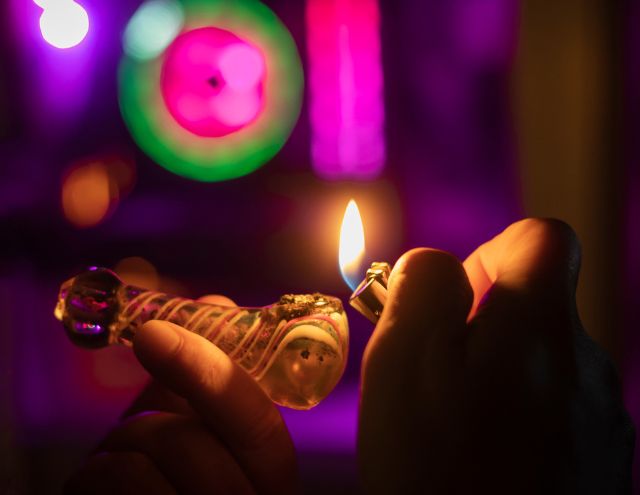
Which Products Are Best for Supporting the Entourage Effect?
More or less, if you want to maximise the entourage effect, you should choose products that contain a wide range of natural cannabis compounds. When it comes to cannabis, the closest you can get to the living plant will produce an entourage effect the most efficiently. That said, good old-fashioned flower is as strong as it gets since you get all of the natural cannabinoids, terpenes, and flavonoids the plant has to offer.
However, concentrates made from still-living plants, like live rosin or live resin, are a great second choice. Live plants contain live terpenes that haven’t been lost to the environment through the process of drying, meaning you get more terpenes and cannabinoids in a concentrated form that promotes the synergy and amplifies the effects.
Full-spectrum products, such as vape cartridges, tinctures, and whole-flower options, are ideal choices as they preserve the natural balance of cannabinoids, terpenes, and flavonoids found in the cannabis plant. On the other hand, there are also broad-spectrum and isolate products out there. Broad-spectrum products are usually refined to remove THC from the mix, and without it, the therapeutic effects may not feel as strong. On the other hand, isolates cannot support an entourage effect because there are no other cannabinoids, terpenes, or flavonoids available to synergise with.
By opting for full-spectrum products, you get the full potential of the entourage effect. Therefore, when selecting cannabis products, prioritising those that contain as many natural compounds as possible is essential for maximising the entourage effect and reaping its full benefits.
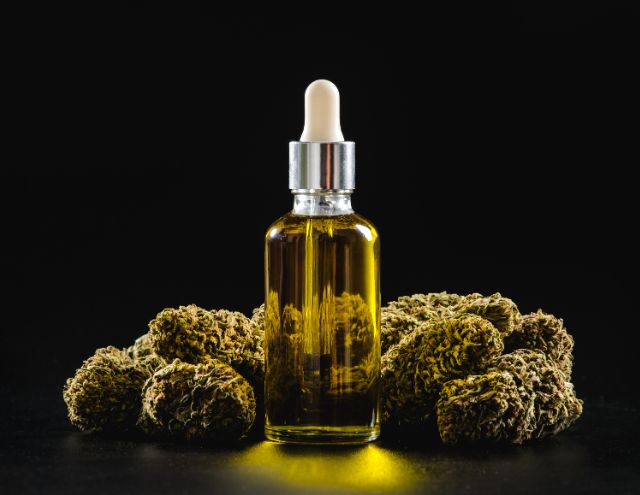
Conclusion
The entourage effect encapsulates the collaborative harmony between cannabinoids, terpenes, and flavonoids within cannabis, showcasing their collective potential for therapeutic synergy. Acknowledging this phenomenon allows you to make more informed choices about weed and prioritise products that preserve the natural balance of compounds found in the plant.
Whether for medicinal relief or recreational enjoyment, the entourage effect serves as a guiding principle, reminding us of the remarkable synergy that lies within the cannabis plant. By opting for full-spectrum extracts and whole-flower options, you can maximise the entourage effect, unlocking a more holistic and comprehensive experience that feels better than enjoying one cannabinoid on its own.






Leave a Reply